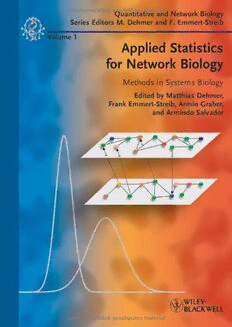
Applied Statistics for Network Biology PDF
Preview Applied Statistics for Network Biology
Edited by Matthias Dehmer, Frank Emmert-Streib Armin Graber, and Armindo Salvador Applied Statistics for Network Biology Related Titles Emmert-Streib, F.,Dehmer, M.(eds.) Medical Biostatistics for Complex Diseases 2010 ISBN:978-3-527-32585-6 Dehmer,M.,Emmert-Streib, F.(eds.) Analysis of Complex Networks FromBiologytoLinguistics 2009 ISBN:978-3-527-32345-6 Emmert-Streib, F.,Dehmer, M.(eds.) Analysis of Microarray Data ANetwork-BasedApproach 2008 ISBN:978-3-527-31822-3 Junker,B. H.,Schreiber,F. Analysis of Biological Networks 2008 ISBN:978-0-470-04144-4 Stolovitzky,G., Califano,A.(eds.) Reverse Engineering Biological Networks OpportunitiesandChallengesinComputationalMethodsforPathwayInference 2007 ISBN:978-1-57331-689-7 Quantitative and Network Biology Series Editors M. Dehmer and F. Emmert-Streib Volume 1 Applied Statistics for Network Biology Methods in Systems Biology Edited by Matthias Dehmer, Frank Emmert-Streib, Armin Graber, and Armindo Salvador TheEditors LimitofLiability/DisclaimerofWarranty:Whilethe publisherandauthorhaveusedtheirbesteffortsin MatthiasDehmer preparingthisbook,theymakenorepresentations UMIT orwarrantieswithrespecttotheaccuracyor InstituteforBioinformatics completenessofthecontentsofthisbookand andTranslationalResearch specificallydisclaimanyimpliedwarrantiesof EduardWallnöferZentrum1 merchantabilityorfitnessforaparticularpurpose. 6060Hall,Tyrol Nowarrantycanbecreatedorextendedbysales Austria representativesorwrittensalesmaterials.TheAdvice andstrategiescontainedhereinmaynotbesuitable foryoursituation.Youshouldconsultwitha FrankEmmert-Streib professionalwhereappropriate.Neitherthe QueensUniversityBelfast publishernorauthorsshallbeliableforanylossof CenterforCancerResearchandCellBiology profitoranyothercommercialdamages,including 97,LisburnRoad butnotlimitedtospecial,incidental,consequential, BelfastBT97BL orotherdamages. UnitedKingdom LibraryofCongressCardNo.: appliedfor ArminGraber UMIT BritishLibraryCataloguing-in-PublicationData InstituteforBioinformatics Acataloguerecordforthisbookisavailablefromthe andTranslationalResearch BritishLibrary. EduardWallnöferZentrum1 6060Hall,Tyrol Bibliographicinformationpublishedby Austria theDeutscheNationalbibliothek TheDeutscheNationalbibliothekliststhis and publicationintheDeutscheNationalbibliografie; NovartisPharmaceuticalsCorporation detailedbibliographicdataareavailableonthe OncologyBiomarkersandImaging Internetathttp://dnb.d-nb.de. OneHealthPlaza EastHanover,NJ07936 #2011Wiley-VCHVerlag&Co.KGaA, USA Boschstr.12,69469Weinheim,Germany ArmindoSalvador Wiley-BlackwellisanimprintofJohnWiley&Sons, formedbythemergerofWiley’sglobalScientific, UniversityofCoimbra Technical,andMedicalbusinesswithBlackwell CenterforNeuroscienceand Publishing. CellBiology,DepartmentofChemistry 3004-535Coimbra Allrightsreserved(includingthoseoftranslationinto Portugal otherlanguages).Nopartofthisbookmaybe reproducedinanyform–byphotoprinting, Composition ThomsonDigital,Noida,India microfilm,oranyothermeans–nortransmittedor PrintingandBinding betz-druckGmbH,Darmstadt translatedintoamachinelanguagewithoutwritten CoverDesign AdamDesign,Weinheim permissionfromthepublishers.Registerednames, trademarks,etc.usedinthisbook,evenwhennot specificallymarkedassuch,arenottobeconsidered unprotectedbylaw. PrintedintheFederalRepublicofGermany Printedonacid-freepaper ISBN:978-3-527-32750-8 V Contents Preface XVII List of Contributors XIX PartOne Modeling,Simulation,andMeaningofGeneNetworks 1 1 NetworkAnalysistoInterpretComplexPhenotypes 3 HongYu,JialiangHuang,WeiZhang,andJing-DongJ.Han 1.1 Introduction 3 1.2 IdentificationofImportantGenesbasedonNetwork Topologies 5 1.2.1 Degree 5 1.2.2 Betweenness 6 1.2.3 NetworkMotifs 6 1.2.4 HierarchicalStructure 7 1.3 InferringInformationfromKnownNetworks 8 1.3.1 UnderstandingBiologicalFunctionsbasedon NetworkModularity 8 1.3.2 InferringFunctionalRelationshipsandNovelFunctional GenesThroughNetworks 8 1.3.3 UnravelingTranscriptionalRegulationsfromExpression DatathroughTranscriptionalNetworks 9 1.3.4 ExtractingthePathway-LinkedRegulatorsandEffectors basedonNetworkFlows 10 1.4 Conclusions 10 References 11 2 StochasticModelingofGeneRegulatoryNetworks 13 TianhaiTian 2.1 Introduction 13 2.2 DiscreteStochasticSimulationMethods 14 2.2.1 SSA 15 2.2.2 Acceleratingt-LeapMethods 16 2.2.3 LangevinApproach 19 VI Contents 2.3 DiscreteStochasticModeling 20 2.3.1 StochasticModelingMethod 20 2.3.2 ToggleSwitchwiththeSOSPathway 22 2.3.3 OtherModelsfortheGeneticToggleSwitch 24 2.4 ContinuousStochasticModeling 26 2.4.1 DeterministicModelsforthelPhageNetwork 26 2.4.2 StochasticModelsforExternalNoise 28 2.4.3 DeterministicModelswithThresholdValues 29 2.4.4 StochasticSwitching 30 2.5 StochasticModelsforBothInternalandExternal Noise 31 2.5.1 StochasticModelsforMicroarrayGene ExpressionData 33 2.6 Conclusions 34 References 35 3 ModelingExpressionQuantitativeTraitLociinMultiple Populations 39 Ching-LinHsiaoandCathyS. J.Fann 3.1 Introduction 39 3.1.1 DataStructureineQTLStudies 39 3.1.2 CurrenteQTLStudies 40 3.1.2.1 eQTLStudiesinaSingleHumanPopulation 40 3.1.2.2 eQTLStudiesinMultipleHumanPopulations 43 3.1.3 AnIllustratedExample 45 3.1.4 Notations 46 3.2 IGMMethod 47 3.2.1 ModelingSNP–GEAssociationinaSinglePopulation 47 3.2.2 IntegratingHypothesestoIdentifyCommoneQTL 48 3.2.3 ApplyingtheIGMMethodtoHapMapData 48 3.2.3.1 CharacterizingPutativeeQTLIdentifiedbytheIGM 49 3.3 CTWM 50 3.3.1 ModelingSNP–GEAssociationinPooledData byCTWM 50 3.3.2 ApplyingCTWMtoHapMapData 52 3.3.2.1 CharacterizingPutativeeQTLIdentifiedbyCTWM 52 3.3.2.2 JustificationofModelAssumptions 53 3.4 CTWM-GSMethod 53 3.4.1 SolvingNormalEquationsinCTWM 54 3.4.2 EstimatorsofBDandGS 55 3.4.3 TestingBDandGS 56 3.4.4 ApplyingCTWM-GStoHapMapData 56 3.4.4.1 ApplyingtheGStoPopulationStudies 57 3.5 Discussion 60 References 61 Contents VII PartTwo InferenceofGeneNetworks 67 4 TranscriptionalNetworkInferenceBasedon InformationTheory 69 PatrickE.Meyer,CatharinaOlsen,andGianlucaBontempi 4.1 Introduction 69 4.1.1 Notation 69 4.1.2 Formalization 71 4.1.3 PerformanceMeasuresinUndirectedNetwork Inference 72 4.1.3.1 Precision–Recall(PR)Curves 73 4.1.3.2 F-Scores 74 4.1.4 CausalSubsetSelection 74 4.2 InferenceBasedonConditionalMutual Information 76 4.2.1 Constraint-BasedMethods 77 4.2.2 ApproximatedConditionalMutualInformation 78 4.2.3 VariableSelectionAlgorithms 78 4.3 InferenceBasedonPairwiseMutualInformation 80 4.3.1 RelevanceNetwork(RELNET) 80 4.3.2 ContextLikelihoodofRelatedness(CLR) 81 4.3.3 Chow–LiuTree 81 4.3.4 AlgorithmfortheReconstructionofAccurateCellular Networks(ARACNE) 82 4.3.5 MinimumRedundancyNetworks(MRNET) 83 4.4 ArcOrientation 84 4.4.1 AssessingArcOrientationMethods 86 4.5 Conclusions 87 References 87 5 ElucidationofGeneralandCondition-DependentGenePathways UsingMixtureModelsandBayesianNetworks 91 SandraRodriguez-ZasandYounheeKo 5.1 Introduction 91 5.2 Methodology 92 5.2.1 NetworkLearningAlgorithms:Frequentist-andBayesian MCMC-basedalgorithms 93 5.3 Applications 95 5.3.1 ElucidationofGeneNetworks 95 5.3.2 DiscoveryofCondition-DependentGene Relationships 96 5.3.3 MCMCMixtureBayesianNetwork 99 5.3.4 ComputationalConsiderations 101 5.4 Conclusions 101 References 102 VIII Contents 6 MultiscaleNetworkReconstructionfromGeneExpression Measurements:Correlations,Perturbations,and‘‘APriori BiologicalKnowledge’’ 105 DanielRemondiniandGastoneCastellani 6.1 Introduction 105 6.1.1 ComplexNetworks 105 6.1.2 GeneInteractionNetworksfromGeneExpression Measurements 107 6.2 ‘‘PerturbationMethod’’ 108 6.3 NetworkReconstructionbytheCorrelationMethod fromTime-SeriesGeneExpressionData 109 6.4 NetworkReconstructionfromGeneExpressionDataby APrioriBiologicalKnowledge 110 6.5 ExamplesandMethodsofCorrelationNetworkAnalysis onTime-SeriesData 112 6.6 ExamplesandMethodsforPathwayNetworkAnalysis 117 6.6.1 GeneSelectionandPathwayGrouping 118 6.6.2 PathwaySignificanceandPathwayNetwork 118 6.6.3 Results 121 6.7 Discussion 126 6.8 Conclusions 127 References 128 7 GeneRegulatoryNetworksInference:Combininga GeneticProgrammingandH1FilteringApproach 133 LijunQian,HaixinWang,andXiangfangLi 7.1 Introduction 133 7.2 Background 134 7.2.1 NoiseinGeneExpression 134 7.2.2 ModelingofGeneRegulatoryNetworkswith Noise 136 7.2.2.1 BooleanNetworksModelwithNoise 136 7.2.2.2 BayesianNetworksModelwithNoise 136 7.2.2.3 LinearAdditiveRegulationModelwithNoise 137 7.2.2.4 NeuralNetworksModelwithNoise 137 7.2.3 ProposedNonlinearODEModelwithNoise 138 7.3 MethodologyforIdentificationandAlgorithm Description 139 7.3.1 GP 140 7.3.2 H1Filter 142 7.4 SimulationEvaluation 144 7.4.1 SyntheticData 144 7.4.2 MicroarrayData 145 7.5 Conclusions 146 References 150 Contents IX 8 ComputationalReconstructionofProteinInteractionNetworks 155 KonradMönks,IrmgardMühlberger,AndreasBernthaler,RaulFechete, PaulPerco,RudolfFreund,ArnoLukas,andBerndMayer 8.1 Introduction 155 8.1.1 SelectingRelevantFeaturesfromOmicsProfiles 156 8.1.2 AnalyzingOmicsDataonaNetworkLevel 157 8.2 ProteinInteractionNetworks 159 8.2.1 NetworkCategories 159 8.2.1.1 MetabolicNetworks 159 8.2.1.2 ParalogNetworks 160 8.2.1.3 PhysicalInteractionNetworks 160 8.2.2 ParametersforProteinAnnotation 161 8.2.2.1 GeneExpressionProfiles 161 8.2.2.2 SubcellularLocation 161 8.2.2.3 GeneAnnotation 161 8.2.2.4 TranscriptionFactors 162 8.2.2.5 MicroRNA 162 8.2.2.6 Pathways 162 8.2.3 DataPreparation 163 8.2.3.1 IntegrationofDataSources 163 8.2.3.2 ObtainingEdgeWeights 164 8.2.3.3 DataCompleteness 166 8.2.3.4 DataNormalization 166 8.2.4 DerivingModels 166 8.2.4.1 BasicConsiderations 167 8.2.4.2 ChoosinganAlgorithm 169 8.2.5 ValidationProcedures 169 8.2.5.1 ModelPerformanceEvaluation 169 8.2.5.2 NetworkStructureAssessment 170 8.3 CharacterizationofComputedNetworks 171 8.3.1 EvaluationoftheSpecificProtein–ProteinInteractions 171 8.3.2 ApplicationoftheSpecificProtein–ProteinInteractions 175 8.4 Conclusions 177 References 178 PartThree AnalysisofGeneNetworks 181 9 WhatiftheFitisUnfit?CriteriaforBiologicalSystemsEstimation BeyondResidualErrors 183 EberhardO.Voit 9.1 Introduction 183 9.2 ModelDesign 184 9.3 ConceptsandChallengesofParameterEstimation 187 9.3.1 TypicalParameterEstimationProblems 190 9.3.1.1 DataFitisUnacceptable 190
